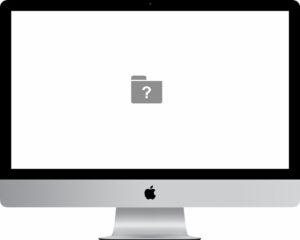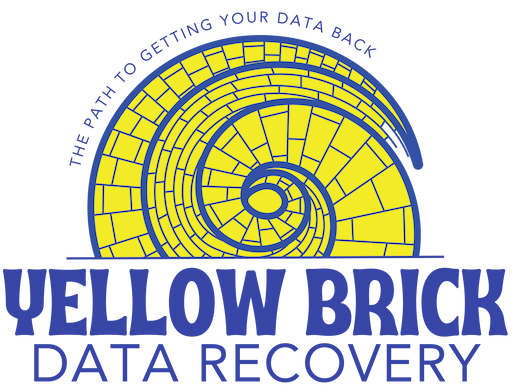If your Mac is showing a flashing folder with question mark at startup, it could be caused by a failed hard drive. If you need Mac data recovery, our affordable data recovery service is a great option.
Mac Data Recovery Service
Up until the last couple of years, Apple used standard drives in most of their computers. And those standard drives they used were all from standard manufacturers. They have used Seagate, Western Digital, Hitachi, Toshiba, and others… they didn’t start using proprietary storage until they switched to the solid state drives in their laptops. Now on a lot of their computers, they actually have the data chips built into the logic board.
No matter what hard drive is inside your Apple computer, our Mac data recovery service is available to help you get your important data back. Our flat rate pricing for Mac data recovery is broken into three tiers. Our Standard tier covers hard drives that are less than 2TB, that don’t have encryption present, and that don’t have advanced firmware issues. The Standard+ tier covers drives that don’t need internal parts replacement but do have encryption present or are over 2TB in capacity. And finally, our clean room Lab Recovery tier is charged for drives that require internal parts replacement.
Affordable Mac Recovery Pricing For Standard Hard Drives
Please note that we have a no data, no charge policy!
If a drive is unrecoverable, there is no charge for the recovery attempt.
Not sure what you need? We can provide you with a free quote. Just fill out our quick quote form and we will get back to you right away. We know how it feels to deal with confusing pricing, so we try our best to make our pricing easy to understand. Hard drive recovery terminology can be daunting, so please feel free to contact us with any questions. We are happy to discuss your particular case and explain which tier we believe the drive will end up requiring.
Bad Hard Drive Symptoms For Mac
There are certain symptoms that, when present, point to the hard drive failing on a Mac.
Flashing Folder With Question Mark

When a Mac computer can not find an operating system to start from, it shows a flashing folder with a question mark on the screen. There are some cases where this could be an issue like the drive was erased on purpose and just needs a new operating system installed, the drive has been removed completely, or the cable from the drive to the logic board is damaged so the computer can’t see the drive. But the basic idea is that the operating system can not be found. More often than not that is due to an issue with the drive itself.
If a drive is in the early stages of failure, it will usually respond enough that the computer will recognize the drive and the operating system on it, and at least start the boot process. So if you get the flashing folder with a question mark on your computer randomly, it is very likely that the drive is having an issue, and it is also likely that the issue is bad enough that the computer doesn’t even recognize any data on the drive.
There is a particular model (the 2012 13” MacBook Pro with DVD slot), that has a very common issue with the hard drive cable. This cable connects the computer’s hard drive to the computer’s logic board. When the cable goes bad (which it very often does), it can cause a few different symptoms, one of which is the flashing folder with the question mark at boot. While this cable fails frequently on the 13” 2012 model, no other models seem to have this issue very commonly.
Blank White Screen At Boot

When you first turn your Mac on, it searches for the drive that it has started from and looks for the operating system on that drive. If the computer finds the drive, but the drive is responding slowly, the computer can get stuck on just a plain white screen.
This plain white screen is the very first screen that comes up before the Apple logo appears. If the computer gets stuck on this screen, there is a good chance that the hard drive is the culprit. The white screen at boot issue can also be related to a graphics card failure or another failure, but in my experience, the most common issue causing the white screen is the hard drive itself.
Prohibited Symbol

Sometimes when you boot your Mac you will see the Apple logo, then immediately after that screen a prohibited symbol will show up on the screen and the computer will not boot any further. This prohibitory symbol means that the computer has found an operating system to start from, but the operating system is corrupted in some way so the computer is not able to boot fully. This corruption could be caused by a failing hard drive.
There are other reasons for this symbol to appear other than a failing drive. Sometimes you will get this symbol if you have installed software that is causing a problem, or if you have tried to install an operating system onto the computer that it is not compatible with. But in the majority of cases, if this issue pops up out of nowhere, it is usually an issue with the hard drive.
Spinning Beach Ball

The spinning beach ball or wheel of death is a symbol that means the computer is working on a task and can temporarily not handle any additional tasks until it completes the one it is working on. There are a lot of reasons you can see the spinning wheel of death, but one of them is a drive that is starting to fail.
You see this symptom a lot with a drive that has a lot of bad sectors. Basically, the computer will try to read or write data from the drive and will hit a bad section. This causes the computer to wait for the data to be read or written for a while before moving onto another section of the drive that isn’t going bad. That pause while it waits for the failing drive causes the spinning wheel to appear and you have to wait for the work to complete before you can continue with your work.
Stalled Startup With Progress Bar

During boot sometimes a Mac can stall or the process bar can move so slowly that it takes 10+ minutes just to boot the computer. This can be caused by a few things, but a very common one is some kind of corruption on the drive.
During the boot process, Mac OS runs a quick file system check on the drive (what is known as the FSCK command). If this check during boot finds anything amiss with the data on the drive, it will attempt to repair the issues, then recheck if the repair was completed successfully. This checking, fixing, and rechecking can take quite a while (especially if your drive is slow or starting to fail).
Spinning Cog During Startup

This one is a little more unusual, but sometimes you get a spinning cog during startup that just never stops. Usually, this is either some kind of corruption on the drive or a drive that is failing. Basically, the computer is not able to complete a task that it is trying to complete during the boot process, so it just keeps trying over and over again.
Computer Turns Off During Boot

This is a pretty classic hard drive issue symptom, although sometimes it can be caused just by corruption on a drive rather than the drive itself. Basically, it is very similar to the stalled progress bar scenario; the computer tries to repair an issue it found during the boot process. If the computer is unable to complete the required repair, it shuts off without any further information being displayed.
When you turn the computer back on again, it will do the exact same thing; start to go through the boot process, the progress bar will slow or stall, then the entire computer will shut off suddenly.
Again, the most common cause of this issue is a drive that is starting to fail in some way that is keeping the computer from fixing the data corruption that is present on the drive.
Unusual or Loud Noises

A computer can make quite a bit of sound. The older models with the louder fans and spinning disk drives can be pretty loud when being used for something more resource hungry. But if you notice sounds that you don’t consider normal coming from your computer, this could be an indication that your hard drive is starting to have issues.
The hard drive noises we are talking about won’t be the same as the fan inside your computer just getting louder as it spins faster to cool the computer. Rather, it will be a usually repetitive clicking or spurts of buzzing, especially when you do something that accesses data on the drive, like opening a file or folder.
Fusion Drive Data Recovery

Some macs, in particular iMacs, have a type of hard drive setup that is called a “Fusion Drive”. A Fusion Drive is a type of setup where two drives are used together to provide storage. With Apple’s setup, a larger slow hard drive is used to store the majority of your files, while a smaller fast solid-state drive is used to store the files that you use most frequently. Some files have pieces of them stored on both drives, so it is important to recover both hard drives during a recovery.
Because a Fusion Drive requires you to recover two drives and then recover the data, the cost for recovery is the data recovery rate x 2. This is the same pricing structure as other RAID devices, where we charge on a per-drive basis.
Types of Mac Data Recovered
We can recover all types of data from your Mac drive. Some Mac programs store data a little differently than Windows programs, so it is important to find a recovery shop like us that understands how to recover your data in a format that makes it easy for you to access.
Photo and Video Recovery from Mac
The most common type of data we are asked to recover from Macs is photos. Personal or professional photos and videos are stored up on our Mac hard drives and are irreplaceable. We are experts at recovering your lost photos and videos.
Photos Library Recovery
A lot of Mac users utilize Apple’s built-in photo storing application called Photos. Photos has a unique way of keeping track of all your Photos and any data you have entered about those photos. It creates a library file that stores the original photo that you imported, along with any changes that you have made to that photo. It stores all edits including keywords you have added, the name of the photo if you have changed it, the location information you added to the photo, the rating you gave the photo, what albums the photo is in, and lots more.
Normally the most important thing to customers is getting the original photo back. Afterall all the other information can be added back over time. We always start by targeting the area of the photo library that holds the original photo data. But once those originals are recovered, we always attempt to recover the entire photo library file. When we are successful in recovering the library file, we use Mac-based software during the recovery to help keep that photo library intact.
Lightroom Data Recovery
Another very common program Mac users utilize to organize their photos is Lightroom by Adobe. We see this program in use mainly by professional photographers, but we also find it in use by a lot of home users that are keeping family photos organized and edited using Lightroom. Lightroom has a catalog file that keeps track of changes made much like Photos, but the original photos themselves are just referenced by Lightroom rather than stored inside the catalog file. This means we attempt to get the original photos back first wherever they are stored on the drive, then go after the catalog file and attempt to recover it without corruption.
Lightroom does have built-in tools for rebuilding its catalog file which is sometimes necessary after data recovery. A repair can be completed on the lightroom catalog by holding down the option key while you boot up the program. A window will come up that will allow you to pick the catalog you want to work with, as well as an option for repairing the corrupt database.
Other Photo and Video Recovery
No matter what program you use on your Mac for storing and organizing your photos, we are able to offer photo recovery services. Just let us know what the most important data is to you when you are filling out our recovery form. If photos and videos are important, just be sure to stipulate the programs that you use to organize the important media so we can focus on it during the recovery process.
Time Machine Drive Recovery
Sometimes the drive you use for your Time Machine backup will fail and the backup history is needed for some reason. We have had clients that have accidently erased important files that they know were backed up on their Time Machine drive, but when they connect the drive to begin recovering the needed data, they find that the backup drive has failed and they need data recovery services to get the files back.
Apple uses a different than normal method for storing their imcremental backups. The way they store the backup data can make recovery a little tricky for a data recovery lab that is not used to working with these drives. We have had a lot of experience with Time Machine drives over the years and are very familiar with the in and outs of recovering data from them.
If you have a Time Machine backup drive or a Time Capsule that you need to get the data from, contact us for our affordable data recovery services.
Messages
It is amazing how much data is stored in our Messages these days. When somebody sends you a photo or a file of some kind, it gets added to the messages database on your device. If your device fails and you have not backed up the needed files, you may need data recovery to get those messages back.
Apple stores the files that Messages references in the user library/Messages. Inside this folder there are the attachments and messages that are referenced by a Messages database. In order to get this information back in a usable form it is important to understand that way Messages works.
Because of my personal background as a Mac technitino, I am ready to take on your Messages data recovery project!
Emails
Most email accounts are setup with either IMAP or Exchange these days, which means a copy of the emails you have are stored on the server. However, some people will move important emails off their email server and store them locally on their Mac. If you have locally stored email messages and you have a hard drive failure, we can help you recover your important email files!
Whether you use Mail, Thunderbird, Entourage (remember Entourage?), Outlook, or some other fancy mail program, we can help you get your email data recovered.
Bookmarks
It is less unusual then you think for bookmarks to show up on the most important data list. It can take years to find all the websites that you need for particular projects or interests, so it shouldn’t be surprising that when you have a hard drive fail in your Mac, bookmarks are data that you would like to recover.
We offer bookmark recovery for all the major browsers including Safari, Firefox, and Chrome. If you use a different browser, just let us know which one and we will get your bookmarks recovered during the data recovery process.
Erased Files
Accidentally erasing files is a very common issue. A lot of the times it is due to accidentally formatting a drive that had important data on it, but sometimes it can just be that you were over zelous during a computer file cleaning session. Whatever the reason for the accidental erasing of the files, we can help you recover them. We offer an affordable rate for erased file recovery.

